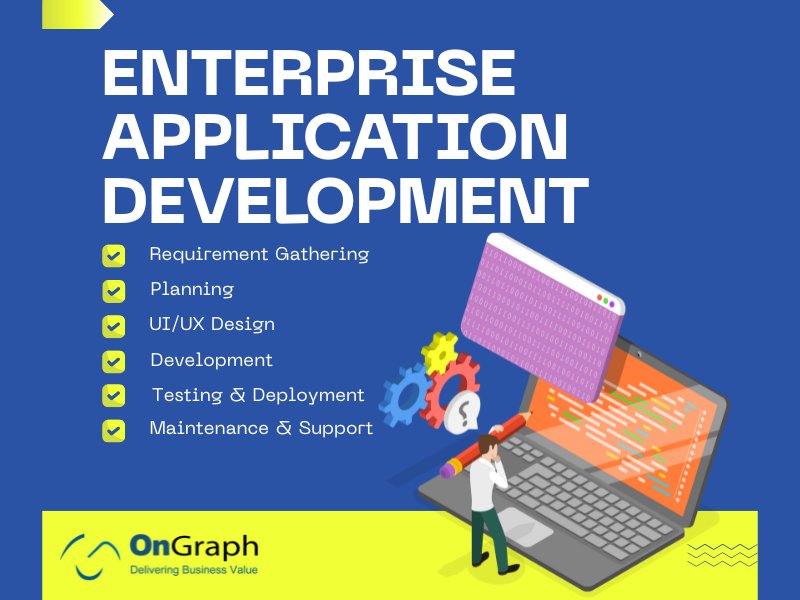In this article
- Introduction to Enterprise Application Development
- Traditional vs. Modern Enterprise App Development
- Types of Enterprise Applications
- Real-World Example: Enterprise Mobile App for Healthcare
- Key Barriers to Enterprise Application Development
- Leveraging Low-Code Platforms
- Cloud Platforms and Enterprise App Development
- Enterprise Application Development Lifecycle
- How OnGraph Delivers Enterprise IT Solutions?
- Conclusion
Enterprise Application Development is more than just building software—it’s about creating tailored, scalable solutions that help large organizations improve performance, streamline operations, and stay ahead of the competition.
In today’s fast-paced digital environment, enterprises require robust platforms that are not only reliable and secure but also adaptive to changing business needs. From cloud integration to mobile-first designs, the scope of enterprise application development is broader and more essential than ever.
Introduction to Enterprise Application Development
At its core, enterprise application development services involve designing and maintaining applications that support an organization’s internal functions and external interactions. These could include ERP systems, HR platforms, CRM tools, or enterprise web application development platforms tailored for customer portals and analytics.
In 2025, the focus has shifted to agile, scalable, and cloud-native enterprise IT solutions that adapt to evolving user expectations and technology landscapes.
Traditional vs. Modern Enterprise App Development
| Aspect | Traditional | Modern |
| Methodology | Waterfall | Agile, DevOps, CI/CD |
| Flexibility | Low | High |
| Collaboration | Siloed | Cross-functional teams |
| Customer Feedback | Rare | Continuous |
| Speed to Market | Slow | Fast |
| Scalability | Post-launch upgrades | Built for scale from day one |
| Cost-efficiency | Higher overruns | Predictable, iterative investment |
| Innovation | Limited | Continuous through feedback and iteration |
| Technology Use | Fixed stack | Cloud, AI, APIs, microservices |
| Project Management | Top-down | Adaptive & iterative |
This shift highlights the importance of agile methodologies in enterprise app development and the benefits of integrating modern tech stacks from the outset.
Types of Enterprise Applications
Here are key types of applications built through custom enterprise application development:
- Asset Management Apps – Track, manage, and maintain assets across geographies.
- HRMS (Human Resource Management System) – Automates payroll, attendance, hiring, and compliance.
- Procurement Apps – Streamline purchasing, vendor management, and invoice tracking.
- Customer Support Apps – Improve service delivery and customer satisfaction with ticketing and live chat.
- Sales & CRM Apps – Empower sales teams with lead tracking, pipeline visualization, and real-time updates.
Real-World Example: Enterprise Mobile App for Healthcare
Client: A multi-specialty hospital chain in India
Challenge: Manual appointment booking, disjointed lab and pharmacy systems, and no centralized patient history.
Solution: OnGraph built an enterprise mobile application with doctor booking, lab integration, real-time health records, and patient support chat.
Impact: 40% drop in missed appointments and 60% improvement in patient engagement within 6 months.
This case shows how a reliable enterprise mobile application development company can bring digital maturity to traditional operations.
Scale Smarter – Build a Future-Proof Enterprise App
Key Barriers to Enterprise Application Development
Despite the benefits, several challenges often arise:
1- Legacy Systems: Outdated architecture restricts integration with new tech stacks.
2- Collaboration Gaps: Disconnection between IT and business units causes delays.
3- Skill Shortages: Lack of experienced enterprise application developers stalls innovation.
4- Agility Challenges: Shifting from rigid to agile structures is not easy.
5- Security & Compliance: Enterprise-grade applications must meet strict data protection rules.
Leveraging Low-Code Platforms
Modern enterprise development software often includes low-code platforms like Mendix, OutSystems, and Microsoft Power Apps. These platforms reduce time to market by up to 70% and empower both developers and business users to collaborate effectively.
Example: A logistics enterprise used low-code to digitize its fleet tracking in just 6 weeks, replacing spreadsheets with a real-time mobile dashboard.
Cloud Platforms and Enterprise App Development
Cloud platforms play a foundational role in enterprise application development today. The three major service models are:
- SaaS (Software as a Service): Used for CRM, ERP, collaboration tools.
- PaaS (Platform as a Service): Ideal for rapid development with built-in tools.
- IaaS (Infrastructure as a Service): Offers scalable storage and computing power.
Choosing the right provider depends on performance, security, cost, and integration support.
Enterprise Application Development Lifecycle
1. Requirement Gathering
Stakeholders define business goals, user roles, and must-have features. Methods include interviews, surveys, and workshops.
2. Planning
Project timelines, technology stack, and methodologies (e.g., Scrum, Kanban) are finalized.
3. UI/UX Design
Designers create interactive, user-friendly interfaces with high-fidelity prototypes.
4. Development
Using agile sprints and DevOps pipelines, developers build out functionality iteratively.
5. Testing & Deployment
Comprehensive QA—covering security, performance, and usability—is done before go-live. CI/CD tools enable smooth, zero-downtime deployment.
6. Maintenance & Support
The app is monitored for bugs, user feedback is collected, and features are upgraded regularly—core components of Application Management Services.
Also read- Why Choose Application Management Services in 2025
How OnGraph Delivers Enterprise IT Solutions?
OnGraph offers end-to-end enterprise application development services, combining technical excellence with business strategy. Here’s what sets us apart:
- Industry-Specific Expertise: Healthcare, Fintech, Logistics, and Retail
- Cloud-First Architecture: AWS, Azure, GCP
- Cross-Platform Development: Web, Android, iOS
- 24/7 Support & Maintenance: SLA-backed services
- Agile Delivery: Rapid MVP launch and continuous improvement
Whether you need a custom CRM or an employee management portal, our enterprise app development services help you innovate at speed and scale.
Transform Workflows – Tailored Enterprise Apps
Conclusion
The future of enterprise application development is agile, cloud-based, and deeply integrated with business objectives. Whether you’re modernizing legacy systems or building a new platform from scratch, success lies in having the right strategy, team, and tools in place.
Partnering with a trusted enterprise mobile application development company like OnGraph ensures you stay ahead in a fast-changing digital world.
FAQs
Enterprise Application Development refers to the process of creating large-scale software systems that support the internal operations and external interactions of a business. These applications are built to manage complex workflows, handle large data volumes, and ensure security, scalability, and performance across departments. Examples include ERP, CRM, HRMS, and custom portals for logistics or finance.
The benefits include:
- Improved operational efficiency
- Better data visibility and decision-making
- Enhanced customer and employee experience
- Automation of manual processes
- Scalable systems that grow with your business
By using professional enterprise application development services, companies can future-proof their operations and stay competitive.
Some common types include:
- Enterprise Resource Planning (ERP)
- Customer Relationship Management (CRM)
- Human Resource Management Systems (HRMS)
- Supply Chain and Procurement Systems
- Business Intelligence (BI) Dashboards
- Custom Enterprise Web & Mobile Apps
Each solution is customized based on the business model and operational needs, forming the backbone of modern enterprise IT solutions.
Custom enterprise application development tailors software to your exact needs, ensuring better integration, user experience, and scalability. Off-the-shelf solutions offer generic features and may require compromise or additional customization. Custom solutions are ideal for businesses with unique processes, security standards, or growth plans.
Modern enterprise app development leverages:
- Frontend: Angular, React, Vue.js
- Backend: Node.js, Java, .NET
- Mobile: Flutter, Swift, Kotlin
- Databases: PostgreSQL, MongoDB, Oracle
- Cloud Platforms: AWS, Azure, Google Cloud
- DevOps Tools: Jenkins, Docker, Kubernetes
These technologies ensure performance, security, and scalability in enterprise-level application development.
It depends on complexity. A simple enterprise web portal may take 3–4 months, while a large multi-module system can take 6–12+ months. Timelines vary based on requirements gathering, design, development, testing, and integration phases. Using agile methods and Application Management Services can speed up delivery and ensure smoother iteration.
Look for a company with:
- Proven track record and case studies
- Experience in your industry
- Skilled enterprise application developers
- Strong focus on security, UX, and scalability
- Post-launch application management services
A reliable enterprise mobile application development company like OnGraph will help you launch faster, with fewer risks and long-term support.
About the Author
Let’s Create Something Great Together!
Latest Blog
















